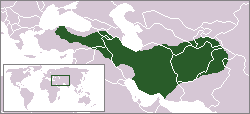
Back Mede Afrikaans ሜዶን Amharic Medians AN ميديون Arabic الميديين ARZ Media (rexión) AST Midiyalılar Azerbaijani ماد ایمپراتورلوغو AZB Мидиялылар Bashkir Мидийци Bulgarian
Median Empire | |||||||||
|---|---|---|---|---|---|---|---|---|---|
| c. 625 BCE–549 BCE | |||||||||
 Median Empire, ca. 600 BC | |||||||||
| Capital | Ecbatana | ||||||||
| Religion | Zoroastrianism possibly also Proto-Iranian religions such as Yazidism | ||||||||
| Government | Monarchy | ||||||||
| King | |||||||||
| Historical era | Iron Age | ||||||||
• Cyaxares united Median tribes[1] | c. 625 BCE | ||||||||
| 549 BCE | |||||||||
| |||||||||
The Medes were an ancient Iranian people and one of the ancestors of modern Kurdish people[2][3][4][5][6][7] who lived in the northwestern portions of present-day Iran. This area was known in Greek as Media or Medea[8] They entered this region with the first wave of Iranian tribes, in the late second millennium BC (at the end of the Bronze Age).[9]
By the 6th century BC, the Medes were able to make their own empire.[10] It stretched from southern shore of the Black Sea and Aran province (in modern Azerbaijan) to north and central Asia, Afghanistan, and Pakistan.
The Medes are credited with the foundation of the first Iranian empire, the largest of its day until Cyrus the Great established a unified Iranian empire of the Medes and Persians, often referred to as the Achaemenid Empire.
- ↑ http://www.britannica.com/EBchecked/topic/372125/Media Encyclopædia Britannica Encyclopedia Article: Media ancient region, Iran
- ↑ "Mede." Encyclopædia Britannica. 2008. Encyclopædia Britannica Online. 16 January 2008 <http://www.britannica.com/eb/article-9051719>.
- ↑ Andrew Dalby, Dictionary of Languages: the definitive reference to more than 400 languages, Columbia University Press, 2004, pg 278.
- ↑ Gwendolyn Leick, Who's Who in the Ancient Near East, Routledge, Published 2001. pg 192
- ↑ Ian Shaw, Robert Jameson, A Dictionary of Archaeology, Blackwell Publishing, 1999.
- ↑ Sabatino Moscati, Face of the Ancient Orient, Courier Dover Publications, Published 2001. pg 67
- ↑ John Prevas, Xenophon's March: Into the Lair of the Persian Lion, Da Capo Press, 2002. pg 20.
- ↑ Μηδία, Old Persian Māda; Kent, Ronald Grubb (2005). Old Persian: grammar, text, glossary (in Persian). translated into Persian by S. Oryan. p. 396. ISBN 964-421-045-X. adjective Median, antiquated also Medean). Under Assyrian rule, the Medes were known as Mādāyu.
- ↑ Daniel J Hopkins, Merriam-Webster's Geographical Dictionary, p. 527, 1997, ISBN 0-87779-546-0
- ↑ Parpola, Simo. "Assyrian identity in ancient times and today" (PDF). Assyriology. Journal of Assyrian Academic Studies. p. 14.
With the fall of Nineveh, the Empire was split in two, the western half falling in the hands of a Chaldean dynasty, the eastern one in the hands of Median kings. In 539 BC, both became incorporated in the Achaemenid Empire, the western one as the megasatrapy of Assyria (AӨūra), the eastern one as the satrapy of Media (Māda).